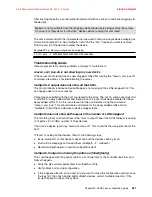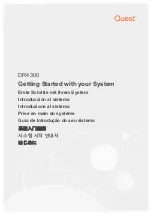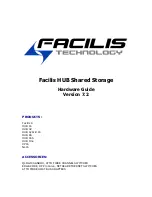
Chapter 21. AIX 6.1 configuration guide
649
Draft Document for Review March 28, 2011 12:24 pm
AIX.fm
two different client partitions. Each client partition has two virtual SCSI adapters. Each client
virtual SCSI adapter connects to a different Virtual I/O Server. The client partition uses MPIO
to provide separate paths to the data disk.
This configuration is very robust, but is more complicated than other configurations. It is
necessary to set up MPIO on the client. Two Virtual I/O Servers need to be installed and
configured. Two or more host bus adapters are needed in each Virtual I/O Server partition.
The Virtual I/O Server is also configured for multipath I/O. The SAN LUNs are mapped as
physical volumes, not logical volumes.
This architecture provides protection from various component outages whether they are
planned (such as for maintenance) or unplanned. For example, it is possible to shutdown one
Virtual I/O Server for a code update without interrupting the client partitions.
Even a SAN switch failure would not prevent the client partitions from getting to their data.
Finally, by using RAID in the SAN LUNs, there is redundancy to a disk failure. Attach an FC
Storage Subsystem to an AIX 6.1 Server.
In this scenario, since the disks are accessed through both Virtual I/O Servers concurrently,
the reserve_policy for each disk must be set to no_reserve on both Virtual I/O Servers.
Change the reserve_policy attribute to no_reserve using the chdev command as shown in
Example 21-4.
Example 21-4 Change the reserve_policy attribute to no_reserve
chdev -dev hdisk2 -attr reserve_policy=no_reserve
hdisk2 changed
Use the lsdev command to make sure reserve_policy attribute is set to no_reserve as shown
in Example 21-5. If you used the -perm parameter, the reserve_policy will be set as
no_reserve but a reboot is needed to apply the change.
Example 21-5 reserve_policy is set as no_reserve
$ lsdev -dev hdisk2 -attr
attribute value description user_settable
PCM PCM/friend/otherapdisk Path Control Module False
PR_key_value none Persistant Reserve Key Value True
algorithm fail_over Algorithm True
autorecovery no Path/Ownership Autorecovery True
clr_q no Device CLEARS its Queue on error True
cntl_delay_time 0 Controller Delay Time True
cntl_hcheck_int 0 Controller Health Check Interval True
dist_err_pcnt 0 Distributed Error Percentage True
dist_tw_width 50 Distributed Error Sample Time True
hcheck_cmd inquiry Health Check Command True
hcheck_interval 60 Health Check Interval True
hcheck_mode nonactive Health Check Mode True
location Location Label True
lun_id 0x0 Logical Unit Number ID False
max_transfer 0x40000 Maximum TRANSFER Size True
node_name 0x20080080e51b0c90 FC Node Name False
pvid none Physical volume identifier False
q_err yes Use QERR bit True
Note: If the vscsi device is in the active state, it will be necessary to add the parameter
-perm at the end. This will update ODM and the setting will take effect on the next reboot.
Summary of Contents for DS3500
Page 2: ......
Page 5: ...iii Draft Document for Review March 28 2011 12 24 pm 7914edno fm ...
Page 789: ......
















































